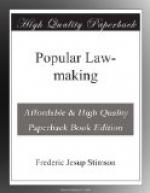[Footnote 1: This, the Trade Boards Act, the 22d chapter of the ninth of Edward VII., enacted October 20, 1909, took effect January 1, 1910. The act applies without specification to ready-made and wholesale tailoring, the making of boxes, machine-made lace and chain-making, and may be applied to other trades by provisional order of the Board of Trade, when confirmed by Parliament. The Board of Trade may make such provisional order applying the act to any specified trade if they are satisfied that the rate of wages prevailing in that trade is exceptionally low as compared with that in other employments, and that the other circumstances of the trade are such as to render the application of the act expedient; and in like manner they may make a provisional order providing that the act shall cease to apply to any trade to which it already was applied. Section 2 provides that the Board of Trade shall establish one or more trade boards for any trade to which the act is to be applied, with separate trade boards for Ireland. These trade boards (section 11) consist of members representing employers and members representing workers in equal proportions, and of certain appointed members. Women are eligible, and the representative members may be elected or nominated as the regulations determine. The chairman and secretary are appointed by the Board of Trade. Such boards are given power to fix minimum rates of wages both for time and piece work, which thereafter must be observed under penalty. There is further a machinery for the establishment of district trade committees. All regulations made by such Boards of Trade shall be laid as soon as possible before both houses of Parliament; but there does not appear to be any other appeal.]
Co-operation and profit-sharing, the great hope of the middle years of the nineteenth century, has made little progress in England or the United States since. Such successful experiments as now exist consist principally in offering to the employees the opportunity to buy the stock of the company at a reasonable rate, as in the case of the Illinois Central Railroad and the United States Steel Company. Many mills, however, give a certain increase in wages at the end of regular periods proportionate to the profits. This technically is what we call profit-sharing. The word “co-operation” should be reserved for institutions actually co-operative; that is to say, where the employees are partners in business with the employers. Of such there are very few in the United States, although there are quite a number in England. In 1901 there were only nineteen co-operative establishments in the United States, most prominent among which are the Peacedale Woolen Mills in Rhode Island; the Riverside Press in Cambridge; Rand, McNally & Co., Chicago; the Century Company, of New York; the Proctor & Gamble Soap Co., of Cincinnati; the Bourne Mills, of Fall River, and the Pillsbury Flour Mills, of Minneapolis. Yet these institutions are really profit-sharing rather




